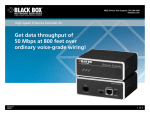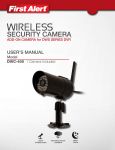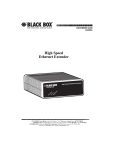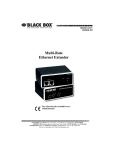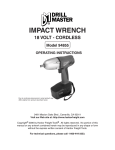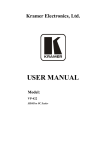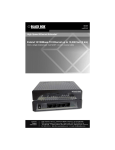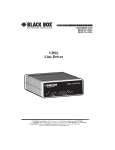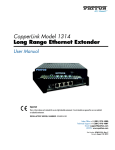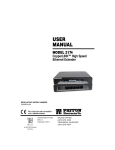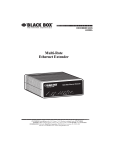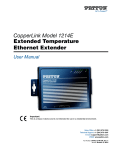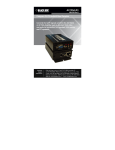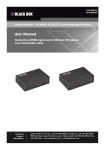Download Black Box VDSL Line Driver User Manual
Transcript
MARCH 2011 LB400A-R2 High Speed Ethernet Extender This is a Class A device and is not intended for use in a residential environment. HIGH SPEED ETHERNET EXTENDER CE NOTICE The CE symbol on your Black Box equipment indicates that it is in compliance with the Electromagnetic Compatibility (EMC) directive and the Low Voltage Directive (LVD) of the European Union (EU). A Certificate of Compliance is available by contacting Technical Support. RADIO AND TV INTERFERENCE This device generates and uses radio frequency energy, and if not installed and used properly-that is, in strict accordance with the manufacturer’s instructionsmay cause interference to radio and television reception. The device has been tested and found to comply with the limits for a Class A computing device in accordance with specifications in Subpart B of Part 15 of FCC rules, which are designed to provide reasonable protection from such interference in a commercial installation. However, there is no guarantee that interference will not occur in a particular installation. If the device does cause interference to radio or television reception, which can be determined by disconnecting the unit, the user is encouraged to try to correct the interference by one or more of the following measures: moving the computing equipment away from the receiver, re-orienting the receiving antenna and/or plugging the receiving equipment into a different AC outlet (such that the computing equipment and receiver are on different branches). Theis device is NOT intended nor approved to be connected to the PSTN. It is intended only for connection to customer premise equipment. WARNING 2 HIGH SPEED ETHERNET EXTENDER This device contains no user serviceable parts. This device can only be repaired by qualified service personnel. • Do not open the device when the power cord is connected. For systems without a power switch and without an external power adapter, line voltages are present within the device when the power cord is connected. • For devices with an external power adapter, the power adapter shall be a listed Limited Power Source. The mains outlet that is utilized to power the device shall be within 10 feet (3 meters) of the device, shall be easily accessible, and protected by a circuit breaker in compliance with local regulatory requirements. • For AC powered devices, ensure that the power cable used meets all applicable standards for the country in which it is to be installed. WARNING • For AC powered devices which have 3 conductor power plugs (L1, L2 & GND or Hot, Neutral & Safety/Protective Ground), the wall outlet (or socket) must have an earth ground. • For DC powered devices, ensure that the interconnecting cables are rated for proper voltage, current, anticipated temperature, flammability, and mechanical serviceability. • WAN, LAN & PSTN ports (connections) may have hazardous voltages present regardless of whether the device is powered ON or OFF. PSTN relates to interfaces such as telephone lines, FXS, FXO, DSL, xDSL, T1, E1, ISDN, Voice, etc. These are known as “hazardous network voltages” and to avoid electric shock use caution when working near these ports. When disconnecting cables for these ports, detach the far end connection first. • Do not work on the device or connect or disconnect cables during periods of lightning activity. 3 HIGH SPEED ETHERNET EXTENDER In accordance with the requirements of council directive 2002/96/EC on Waste of Electrical and Electronic Equipment (WEEE), ensure that at end-of-life you separate this product from other waste and scrap and deliver to the WEEE collection system in your country for recycling. Electrostatic Discharge (ESD) can damage equipment and impair electrical circuitry. It occurs when electronic printed circuit cards are improperly handled and can result in complete or intermittent failures. Do the following to prevent ESD: • Always follow ESD prevention procedures when removing and replacing cards. WARNING • Wear an ESD-preventive wrist strap, ensuring that it makes good skin contact. Connect the clip to an unpainted surface of the chassis frame to safely channel unwanted ESD voltages to ground. • To properly guard against ESD damage and shocks, the wrist strap and cord must operate effectively. If no wrist strap is available, ground yourself by touching the metal part of the chassis TRADEMARKS USED IN THIS MANUAL All applied-for and registered trademarks are the property of their respective owners. NORMAS OFICIALES MEXICANAS (NOM) ELECTRICAL SAFETY STATEMENT Instrucciones De Seguridad 1. Todas las instrucciones de seguridad y operación deberán ser leídas antes de que el aparato eléctrico sea operado. 2. Las instrucciones de seguridad y operación deberán ser guardadas para referencia futura. 3. Todas las advertencias en el aparato eléctrico y en sus instrucciones de operación deben ser respetadas. 4. Todas las instrucciones de operación y uso deben ser seguidas. 5. El aparato eléctrico no deberá ser usado cerca del agua—por ejemplo, cerca de la tina de baño, lavabo, sótano mojado o cerca de una alberca, etc. 6. El aparato eléctrico debe ser usado únicamente con carritos o pedestales que sean recomendados por el fabricante. 4 HIGH SPEED ETHERNET EXTENDER 7. El aparato eléctrico debe ser montado a la pared o al techo sólo como sea recomendado por el fabricante. 8. Servicio—El usuario no debe intentar dar servicio al equipo eléctrico más allá a lo descrito en las instrucciones de operación. Todo otro servicio deberá ser referido a personal de servicio calificado. 9. El aparato eléctrico debe ser situado de tal manera que su posición no interfiera su uso. La colocación del aparato eléctrico sobre una cama, sofá, alfombra o superficie similar puede bloquea la ventilación, no se debe colocar en libreros o gabinetes que impidan el flujo de aire por los orificios de ventilación. 10. El equipo eléctrico deber ser situado fuera del alcance de fuentes de calor como radiadores, registros de calor, estufas u otros aparatos (incluyendo amplificadores) que producen calor. 11. El aparato eléctrico deberá ser connectado a una fuente de poder sólo del tipo descrito en el instructivo de operación, o como se indique en el aparato. 12. Precaución debe ser tomada de tal manera que la tierra fisica y la polarización del equipo no sea eliminada. 13. Los cables de la fuente de poder deben ser guiados de tal manera que no sean pisados ni pellizcados por objetos colocados sobre o contra ellos, poniendo particular atención a los contactos y receptáculos donde salen del aparato. 14. El equipo eléctrico debe ser limpiado únicamente de acuerdo a las recomendaciones del fabricante. 15. En caso de existir, una antena externa deberá ser localizada lejos de las lineas de energia. 16. El cable de corriente deberá ser desconectado del cuando el equipo no sea usado por un largo periodo de tiempo. 17. Cuidado debe ser tomado de tal manera que objectos liquidos no sean derramados sobre la cubierta u orificios de ventilación. 18. Servicio por personal calificado deberá ser provisto cuando: A. El cable de poder o el contacto ha sido dañado; u B. Objectos han caído o líquido ha sido derramado dentro del aparato; o C. El aparato ha sido expuesto a la lluvia; o D. El aparato parece no operar normalmente o muestra un cambio en su desempeño; o E. El aparato ha sido tirado o su cubierta ha sido dañada. 5 HIGH SPEED ETHERNET EXTENDER CONTENTS CE Notice .................................................................................................... 2 Radio and TV Interference .......................................................................... 2 Trademarks Used In This Manual ............................................................... 3 Normas Oficiales Mexicanas (NOM) Electrical Safety Statement ............. 3 1. General Information ....................................................................................6 1.1 Features ...............................................................................................6 1.2 Description ......................................................................................... 6 2. Installation ................................................................................................... 8 2.1 Connecting the Twisted-Pair Line Interface .......................................9 2.2 Connecting the 10/100Base-T Ethernet Interface ............................ 10 2.3 Connecting Power ............................................................................ 11 3. Configuration............................................................................................. 12 3.1 Configuring DIP Switch S1 ..............................................................14 3.1.1 S1-2: Impulse Noise Protection .............................................14 3.1.2 S1-3: Rate Limit .................................................................... 14 3.1.3 S1-4: General Protection (Signal to Noise Ratio).................. 14 4. Operation ................................................................................................... 15 4.1 Power Up ..........................................................................................15 4.2 Front Panel LED Status Monitors .................................................... 15 A. Specifications ............................................................................................ 16 A.1 LAN Connection ..............................................................................16 A.2 Transmission Line ............................................................................16 A.3 Line Rate and Distance .....................................................................16 A.4 LED Status Indicators .......................................................................16 A.5 Power Supply ....................................................................................16 A.6 Temperature Range ..........................................................................16 A.7 Humidity ...........................................................................................17 A.8 Dimensions .......................................................................................17 B. High Speed Ethernet Extender Interface Pin Assignment......................... 18 B.1 10/100Base-T Interface ....................................................................18 B.2 Line Interface ....................................................................................18 6 HIGH SPEED ETHERNET EXTENDER C. Sample Rates/Distance Chart, Based on 24 AWG (0.5 MM) ................... 19 Notes.......................................................................................................... 20 Notes.......................................................................................................... 21 7 HIGH SPEED ETHERNET EXTENDER 1. General Information Thank you for your purchase of this Black Box product. If any questions arise during installation or use of the unit, contact Black Box Tech Support at (724) 746-5500. 1.1 Features • Variable rate ethernet extender - Easy to configure • Auto-MDIX Ethernet • Configurable 10/100, Full/Half, and Auto-Negotiating Ethernet • Extends network connections up to 5,500 ft (1.6 km) over 2-wire 24-AWG unconditioned lines • Auto-Rate line rates up to 100 Mbps downstream/70 Mbps upstream • Symmetric or asymmetric settings via DIP switch • Transparent operation • LED indicators for Power, Link, Ethernet Link & Activity, and Remote/Local 1.2 Description The Black Box LB401A Ethernet Extenders provide high-speed LAN connections between peered Ethernet LANs, remote PCs, or any other network enabled 10/100Base-T device. Operating in pairs, one LB401A is configured as the (L) Local unit located at one end of the LAN extension and the other LB401A is configured as the (R) Remote unit at the other end. The LB401A is configured as a L or R via the switch on the bottom of the unit. These units can automatically forward LAN broadcasts, multicasts, and frames across a 2-wire voice-grade twisted-pair link. The data is passed transparently (unmodified) through the 2173s. The 2173s automatically add and delete MAC addresses, only passing packets across the LINE link that are meant for the remote peered LAN. 8 HIGH SPEED ETHERNET EXTENDER Figure 1. Typical application The pair of LB401A models work together to create a transparent extension between two peered Ethernet LANs. Figure 1 shows a typical point-to-point application. 9 HIGH SPEED ETHERNET EXTENDER 2. Installation The Interconnecting cables shall be acceptable for external use and shall be rated for the proper application with respect to voltage, current, anticipated temperature, flammability, and mechanical serviceability. CAUTION To install the LB401A Ethernet Extender, do the following: 1. Connect the line interface between the units (refer to section 2.1, “Connecting the Twisted-Pair Line Interface” on page 11) Note See Figure 2 for the standalone unit’s rear panel arrangements. 2. Connect the Ethernet interface (refer to section 2.2, “Connecting the 10/100Base-T Ethernet Interface” on page 12). 3. Connect the power plug (refer to section 2.3, “Connecting Power” on page 13). LB401A de Ma in the A US r we Po e Lin Power jack t ne er Eth 1 2 CopperLINK twisted-pair RJ-45 interface Dual 10/100 Ethernet ports Figure 2. High Speed Ethernet Extender rear panel 10 HIGH SPEED ETHERNET EXTENDER 2.1 Connecting the Twisted-Pair Line Interface The High Speed Ethernet Extender supports communication between two peer Ethernet LAN sites over a distance of up to 5,500 ft (1.6 km) over 24 AWG (0.5 mm) twisted-pair wire. Note Actual distance and link performance may vary depending on the environment and type/gauge of wire used. Follow the steps below to connect the High Speed Ethernet Extender interfaces. Note The LB401A units work in pairs. One of the units must be configured as a (L) Local unit, and the other unit must be configured as a (R) Remote unit. 1. To function properly, the two LB401As must be connected together using twisted-pair, unconditioned, dry, metal wire, between 19 (0.9mm) and 26 AWG (0.4mm). Leased circuits that run through signal equalization equipment are not acceptable. 2. The LB401A is equipped with an RJ-45 interface jack that can be used on the LINE interface. The LINE interface is a two-wire interface. Observe the signal/pin relationships on the LB401A's LINE interface jack. The RJ-45 connector on the LB401A's twisted pair interface is polarity insensitive and is wired for a two-wire interface. The signal/pin relationship is shown in Figure 3. 1 (no connection) 1 2 3 4 5 6 7 8 2 (no connection) 3 (no connection) 4 (RING) 5 (TIP) 6 (no connection) 7 (no connection) 8 (no connection) Figure 3. (RJ-45) twisted pair line interface. 11 HIGH SPEED ETHERNET EXTENDER 2.2 Connecting the 10/100Base-T Ethernet Interface The Interconnecting cables shall be acceptable for external use and shall be rated for the proper application with respect to voltage, current, anticipated temperature, flammability, and mechanical serviceability. CAUTION The shielded RJ-45 ports labeled Ethernet are the Auto-MDIX10/100Base-T interface. These ports are designed to connect directly to a 10/100Base-T network. Figure 4 shows the signal/pin relationships on this interface. You may connect this port to a hub or PC using a straight through or crossover cable that is up to 328 ft long. 1 TX+/RX+ 1 2 3 4 5 6 7 8 2 TX-/RX3 RX+/TX+ 4 (no connection) 5 (no connection) 6 RX-/TX7 (no connection) 8 (no connection) Figure 4. 10/100Base-T RJ-45 Connector Pinout. 12 HIGH SPEED ETHERNET EXTENDER 2.3 Connecting Power The Interconnecting cables shall be acceptable for external use and shall be rated for the proper application with respect to voltage, current, anticipated temperature, flammability, and mechanical serviceability. CAUTION The LB401A does not have a power switch, so it powers up as soon as it is plugged in. An external AC or DC power supply is available separately. This connection is made via the barrel jack on the rear panel of the LB401A. No configuration is necessary for the power supply (See Appendix B for domestic and international power supply and cord options). DC power (supplied via the power supply jack to the LB401A) must meet the following requirements; DC power supplied must be regulated +5VDC ±5%, 1.0A minimum. Center pin is +5V. The barrel type plug has a 2.5/5.5/10mm I.D./O.D./Shaft Length dimensions. 13 HIGH SPEED ETHERNET EXTENDER 3. Configuration The LB401A has four DIP switches (S1) for configuring the unit for a wide variety of applications. This section describes switch locations and explains the different configurations. Using a small flat-tip screwdriver, remove the protective cover located on the underside of the Ethernet Extender (see Figure 5). Link Hig hS pe ed Eth er ne tE xte nd er 14 Pow er Rem ote Loca l Ethe rnet 1 Ethe rnet 2 Figure 5. Removing protective cover HIGH SPEED ETHERNET EXTENDER 1 2 3 4 Front ON Figure 6 shows the orientation of the DIP switches in the On and Off positions. Rear S1 Switch toggle ON 1 2 Push toggle down for OFF position 4 S1 Push toggle up ON for ON position 3 1 2 3 4 Figure 6. DIP switch orientation 15 HIGH SPEED ETHERNET EXTENDER 3.1 Configuring DIP Switch S1 DIP switch S1 is where you configure the LINE. The following tables describe the configuration for the LB401A. Table 1: LB401A Firmware Configuration S1-1 S1-2 S1-3 S1-4 Position Master/ Slave Mode Rate SNR ON Slave (CPE) Fast Auto 6dB OFF Master (CO) Interleave 25/25 9dB 3.1.1 S1-2: IMPULSE NOISE PROTECTION • Fast Mode: Direct data transmission with latency less than 1ms • Interleave Mode: Provides data transmission protection for up to 250 ms impulse noise with latency less than 6 ms 3.1.2 S1-3: RATE LIMIT S1-3 Rate OFF ON 25/25 Auto 3.1.3 S1-4: GENERAL PROTECTION (SIGNAL TO NOISE RATIO) • 6dB: Original line noise protection with 6dB SNR • 9dB: Better line noise protection with SNR up to 9dB 16 HIGH SPEED ETHERNET EXTENDER 4. Operation Once the High Speed Ethernet Extenders are properly installed, they should operate transparently. No user settings required. This section describes reading the LED status monitors. 4.1 Power Up Before applying power to the LB401A, review section 2.3, “Connecting Power” on page 13 to verify that the unit is connected to the appropriate power source. 4.2 Front Panel LED Status Monitors The LB401A features six front panel LEDs that monitor power, the Ethernet signals, the LINE connection, and the remote/local setting. Figure 7 shows the front panel location of each LED. Table 2 on page 15 describes the LED functions. BLACK BOX r we Po Power LED Link LED nk Li High Speed Ethernet Extender 2 1 et et l rn rn ca he he Et Et Lo e ot m Re Ethernet 1 Ethernet 2 Local Remote LED LED LED LED Figure 7. LB401A front panel Table 2: Front panel LED description LED Power Line Ethernet Status Green Off Green Blinking Green Off Green *Blinking Local Remote Green Off Green Off Green Description The device is powered on. The device is powered off. The port is connected. Data transceiving. No valid link on this port. The port is connected. Data transceiving. The device acts in Local mode. Local mode is off. The device acts in Remote mode. Remote mode is off. *. Once the unit connects to a power source, the Link LED will blink as the LB401A automatically looks for the other unit in the pair. 17 HIGH SPEED ETHERNET EXTENDER A. Specifications A.1 LAN Connection • Two shielded RJ-45, 10/100Base-T, IEEE 802.3 Ethernet • Line Connection: Shielded RJ-45 A.2 Transmission Line Two-wire unconditioned twisted pair. A.3 Line Rate and Distance • Line Rate: Up to 155 Mbps aggregate (upstream/downstream) via Auto Rate; and 25/25 Mbps via DIP switch settings. • Distance: Up to 5,500 ft (1.6 km) Note Distances depend on line rate and line conditions. A.4 LED Status Indicators • Power (Green) • Line: Link (Green) • Ethernet: Link (Green) & Activity (Flashing Green) • Remote (Green) • Local (Green) A.5 Power Supply External AC and DC options: • AC: 120 VAC, 220 VAC, and UI (120–240 VAC) • DC: 12 VDC, 24 VDC and 48 VDC • Power consumption: 860mA at 5V A.6 Temperature Range 0–40°C 18 HIGH SPEED ETHERNET EXTENDER A.7 Humidity Up to 90% non-condensing. A.8 Dimensions 1.58H x 4.16W x 3.75D in. (10.6H x 4.1W x 8.8D cm) 19 HIGH SPEED ETHERNET EXTENDER B. High Speed Ethernet Extender Interface Pin Assignment B.1 10/100Base-T Interface RJ-45 • Pin 1: TX+ • Pin 2: TX• Pin 3: RX+ • Pin 6: RX• Pins 4, 5, 7, 8: no connection B.2 Line Interface RJ-45 • Pin 4: RING • Pin 5: TIP • Pins 1, 2, 3, 6, 7, 8: no connection 20 HIGH SPEED ETHERNET EXTENDER C. Sample Rates/Distance Chart, Based on 24 AWG (0.5 MM) Rate Mode 4/1 Fast 4/1 Interleave 100/70 Fast 100/70 Interleave 25/25* Interleave 50/50 Fast 50/50 Interleave 70/70 Fast 70/70 Interleave Distance in Feet (km) Throughput at Max Distance (megabits per second) 5,500 (1.6 km) 5,500 (1.6 km) 500 ft (0.15 km) 250 (0.07 km) 2,250 (0.6 km) 1,750 (0.5 km) 1,750 (0.5 km) 1,750 (0.5 km) 1,750 (0.5 km) 4.00 (DS) 1.00 (US) 4.00 (DS) 1.00 (US) 83 (DS) 69.5 (US) 83 (DS) 69.5 (US) 24.89 (DS) 24.89 (US) 49.78 (DS) 49.78 (US) 49.78 (DS) 49.78 (US) 51 (DS) 51 (US) 51 (DS) 51 (US) *. For the 25/25 rate, set S1-3 to the OFF position. Note The actual distance and link performance may vary depending on the environment and type/gauge of wire used. Note DS = downstream, US = upstream 21 HIGH SPEED ETHERNET EXTENDER NOTES ________________________________________________________________ ________________________________________________________________ ________________________________________________________________ ________________________________________________________________ ________________________________________________________________ ________________________________________________________________ ________________________________________________________________ ________________________________________________________________ ________________________________________________________________ ________________________________________________________________ ________________________________________________________________ ________________________________________________________________ ________________________________________________________________ ________________________________________________________________ ________________________________________________________________ ________________________________________________________________ ________________________________________________________________ ________________________________________________________________ ________________________________________________________________ ________________________________________________________________ ________________________________________________________________ 22 HIGH SPEED ETHERNET EXTENDER NOTES ________________________________________________________________ ________________________________________________________________ ________________________________________________________________ ________________________________________________________________ ________________________________________________________________ ________________________________________________________________ ________________________________________________________________ ________________________________________________________________ ________________________________________________________________ ________________________________________________________________ ________________________________________________________________ ________________________________________________________________ ________________________________________________________________ ________________________________________________________________ ________________________________________________________________ ________________________________________________________________ 23
























